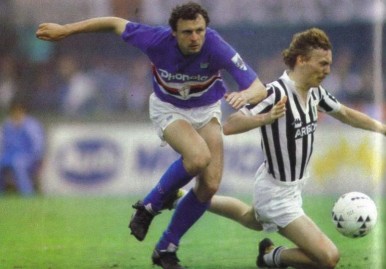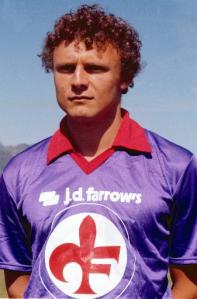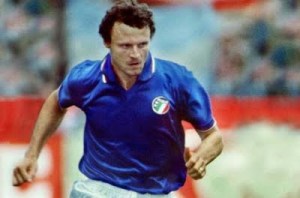For someone who played professional football until he was 41, the prospect of adding another year to the tally must register fairly low in his list of concerns. Pietro Vierchowod turned 53 on Friday and the man once described as ‘an animal’ by Diego Maradona had a career worth recalling. Suitably I’m here to take a compact look at the accomplishments of the man known as ‘Lo Zar’.
The source of the majority of my early football interest came via the much-cherished channel of Football Manager and it’s various iterations. The Italian leagues were introduced in 1996 and a 35-year-old Vierchowod was patrolling Milan’s squad. The thing that stood out was his surname – it didn’t match his Italian nationality. A sweeper too? Not many of those specialists existed within the game. He was an intriguing entity and when I discovered him knocking about as a free transfer five years later, it was obvious that this was a man worth knowing.
The son of a Ukrainian Red Army soldier (hence the ‘Zar’ nickname), Vierchowod’s sterling reputation owed as much to his longevity as his achievements in both club and national football. In a career that spanned 24 years, racking up a mighty 647 club appearances he managed to squeeze in two Scudetto’s, a Cup Winners Cup, four Coppa Italia’s, a Champions League and a World Cup.
Standing a short 5ft 11ins for a centre-half but with a unique turn of pace that elevated him above his defensive peers, Vierchowod bridged two Italian eras, adapting admirably to the changing tactical worlds thrown at him. Initially a classic ‘stopper’, Vierchowod forged his reputation as a fierce man-marker – a vital line of defence in the Catenaccio systems that had started to disperse in the 80’s. As Italian football cast off the shackles of the defensive model that continues to stereotype the reputations of Serie A clubs, Vierchowod became one of the few defenders of the time to span both the 80’s and 90’s with his reputation intact.
Asked who was his toughest opponent was Gary Lineker spoke of the defender: “Vierchowod. He was absolutely brutal and lightning quick.”
He began his career at Romanese in Serie D, making three appearances in the 1974/75 season though his first notable employer was Como in the north of Italy, where he spent five years. The 1978/79 campaign saw him establish himself at the heart of the defence and attain successive promotions from the third tier. Back in Serie A, Como gave him the platform to display his talents and halfway through their two year stay in the top flight he moved on to Sampdoria. He was taken to the Luigi Ferraris by oil tycoon Paolo Mantovani but given two years in Serie A with Fiorentina and Roma. His first year at the Viola was a success and saw the club finish just one point behind Serie A winners Juventus in second place.
In 1983 he finally moved back to his parent club, Sampdoria, where he would further enhance his standing in the game. The ‘Zar’ nickname not only alluded to his heritage but his influence on the pitch and in the dressing room. He would go on to appear for Sampdoria 358 times in Serie A and helped lead them to their first and only Scudetto in 1990/91. He won four Italian Cups, won and finished runner-up in the Cup Winners Cup as well as a runners-up finish in the European Cup in this time.
By now, Vierchowod had competition in the form of the great all-Italian Milan back-line of Paolo Maldini, Franco Baresi, Alessandro Costacurta and Mauro Tassotti. The formation of one of the greatest defences in Italian history saw the same chemistry often supplied to the national team and as such Vierchowod never secured a permanent place in the starting line-up. That said, he did acquire 45 caps – further testament to a distinguished standing in the Italian game. He was also part of the 1990 World Cup squad that finished third.
During his time at Sampdoria, Vierchowod adapted his game and became a more forward-thinking defender, often winning possession and surging from the defensive line, helping to launch counter-attacks.
To draw a modern comparison, Phil Jones’ style of play is reminiscent of the dynamism Vierchowod had during his days at Sampdoria. The competitive spirit and vivacity that separates Jones from his generation did so for Vierchowod throughout the 80’s and 90’s. As well as playing alongside Gianluca Vialli and Roberto Mancini, Vierchowod also faced some of the most fearsome strikers in the world as Italian football attracted the likes of Marco Van Basten, Rudi Voller, Careca and Diego Maradona.
On Vierchowod, Maradona eulogised: “He was an animal, he had muscles to the eyelashes. It was easy to pass by him, but then when I raised my head, he was in front of me again. I would have to pass him two or three more times and then I would pass the ball because I couldn’t stand him anymore.”
Vierchowod left Sampdoria in 1995 at a time where you’d be forgiven for thinking his time was up. Quite contrary, he moved to Juventus and played in the Champions League final against Ajax, helping stifle the likes of Patrick Kluivert and a 19-year-old Kiki Musampa no less! He helped take the game to penalties and picked up a winners medal aged 37.
As his career wound down, he turned out for Milan in a final big-club swansong before settling down at Piacenza where he helped them battle relegation to Serie B for three seasons. As his physical attributes waned, Vierchowod operated as the sweeper in a three man defence. He famously said in 1999: “I used to be much quicker than everyone else – now I’m just as quick as them.”





